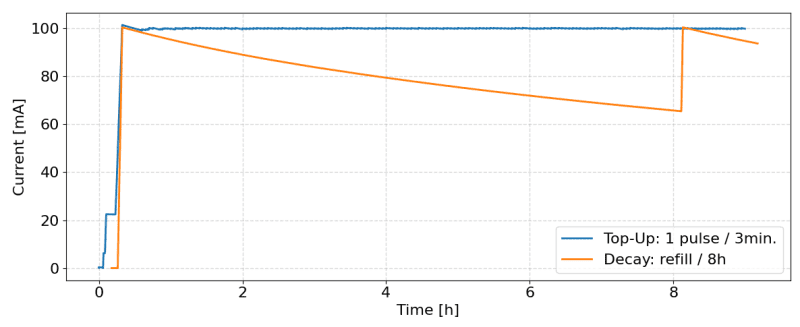
The new operating mode ensures more stability and more photons emitted to the beamlines
Since late March, Sirius has implemented a new operating mode that involves injecting new electrons into the storage accelerator every 3 minutes, guaranteeing that the current remains nearly constant throughout its operations. This results in around 25% more photons emitted per day compared to the previous mode, in which electrons were injected every 8 hours and beam current decayed during this period.
Secure implementation of top-up mode became possible after the development of various accelerator subsystems, such as an interlock system that allows injection while blocking open beamlines, and optimizing the injector system to ensure highly efficient injection.
In this operating mode, the thermal load on the optical elements is practically constant, and as a result the researchers using the facilities at Sirius will have access to a much more stable beamline.
Another advantage of operating in top-up mode is that vertical emittance of the electron beam can be reduced, translating into brighter beams and higher resolution in the experimental stations. In the old mode, vertical emittance was set to a higher value so the beam current would decay more slowly throughout the shift.

Stored beam current during previous operations vs. top-up mode
The process of injecting new electrons into the accelerator uses pulsed magnets that can disturb the stability of the beamline for a fraction of the dozens of milliseconds each pulse lasts. Because in top-up mode injection takes place while experiments are being conducted with the beamlines, it is important that it be done as “transparently” as possible.
Today, research to refine the injection process and make it more transparent is underway at most of the world’s synchrotron light sources. Work at Sirius in this area, involving prototypes that are already operating in the accelerators, has shown great potential to reach a high level of transparency.
For these reasons, top-up mode is considered a major landmark at Sirius. According to Liu Lin, Head of the Division of Accelerator Physics, “Constant thermal load is beneficial for the stability of the optical systems in beamlines and for the equipment in the accelerator itself. And the brighter light and higher number of photons emitted per day ensure a better-quality beam for experiments on the beamlines.”
In the first call for proposals, the new, more inclusive, and collaborative selection process attracted proposals from scientists in 15 countries and 17 Brazilian states, most notably the Northeast of the country.
The beamline is dedicated to X-ray diffraction of polycrystalline materials and will operate in the energy range of 5 to 30 keV